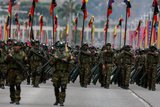Rogov Design's breakthrough LCD displays give Unmanned Aircraft System operators better eyes in the sky
Forging a better connection between human and machine has long been the inspiration for internationally acclaimed industrial designer Vladymir Rogov. With his latest success, he faced the challenge of improving the interface between Unmanned Aircraft Systems (UAS), one of the military's most strategic tools, and the human pilots that translate their captured data. Rogov's breakthrough LCD display system forever changes the way human hands interact with these critical aircraft.
Unmanned Aircraft Systems have myriad military applications, but they are increasingly used in the civilian world in areas from firefighting to surveillance of offshore pipeline operations. Rogov knew that despite its many high-tech applications, a UAS is only as good as its human pilot and camera operator. Maximizing their eyes in the sky was Rogov's charge.
His resulting LCD display design creates a more seamless relationship between a leading Ground Control Station (GCS) and its Unmanned Aircraft Systems. "The purpose of an unmanned system is to allow a human being to project their senses and their ability to affect things into the battle-space," stated Mark Bigham, director of business development for GCS supplier Raytheon, in an industry magazine. "The operator interface is a critical element, and its next big area of improvement."
From their terra firma homebase, pilots look at their world through an array of LCD displays that curve around them, displaying maps, terrain, navigation and inter-communication. The UAS flies in relays, with a new person taking the helm every few hours while the UAS remains in mid-flight. Rogov's revolutionary LCD display system allows the next person to adjust the LCD array to optimize personal settings, ramping up both personal comfort level and technical efficiency.
The GCS' vision systems, a new fully articulating, user-adjustable LCD display array system, meets MIL-STD 1472F human factors guidelines and accommodates the 5th to 95th percentile of male and female flyers to provide an expansive window on the action.
Z Microsystems was selected to deliver these display panels by an undisclosed UAS manufacturer. The company successfully completed its first shipment on the subcontract supporting a UAS program. "This contract validates that our technology is meeting the need for higher fidelity visualization in UAS surveillance," said Jack Wade, Z Microsystems' chief executive officer.
Rogov added, "As pilots and sensors begin to increase the number of unmanned systems they operate at once, the future points to a new breed of control stations, particularly in performing peace-time functions. The military has always been an early adopter of cutting-edge technology. However, the quality of technical savvy is measured by the fact that it becomes less visible as it is integrated as a human-machine user interface.
"We've done it with cars," continued Rogov, whose designs have hit the road in Fords, Fiats and Aston Martins. "This LCD system brings some of the experience of sitting in the ultimate flying machine to UAS flyers.
"This was indeed a worthy project for the right-brain skills of an industrial designer. We have solved bigger problems involving people who are much less interested about their work than these conscientious UAS flyers."
Source: Rogov
More from Uncrewed Vehicles
-
![What's next for the Pentagon after the Replicator programme?]()
What's next for the Pentagon after the Replicator programme?
Although the Replicator initiative has made several accomplishments, there are still multiple gaps to plug across the US Department of Defense (DoD) and its services.
-
![Cummings Aerospace showcases Hellhound loitering munition designed for US Army’s LASSO programme (video)]()
Cummings Aerospace showcases Hellhound loitering munition designed for US Army’s LASSO programme (video)
Cummings Aerospace presented its turbojet-powered Hellhound loitering munition at SOF Week 2025, offering a man-portable solution aligned with the US Army’s LASSO requirements.
-
![SOF Week 2025: PDW unveils attritable FPV drone for SOF operations at scale]()
SOF Week 2025: PDW unveils attritable FPV drone for SOF operations at scale
PDW has revealed its Attritable Multirotor First Person View drone at SOF Week 2025, offering special operations forces a low-cost, rapidly deployable platform for strike and ISR missions, inspired by battlefield lessons from Ukraine.
-
![SOF Week 2025: Teledyne FLIR white paper provides guidance on reusable loitering munitions]()
SOF Week 2025: Teledyne FLIR white paper provides guidance on reusable loitering munitions
Teledyne FLIR is highlighting the emerging requirements for 'recoverable and re-usable' loitering munitions across the contemporary operating environment during this week’s SOF Week conference in Tampa, Florida.
-
![SOF Week 2025: Kraken Technology group debuts K3 Scout USV in North America]()
SOF Week 2025: Kraken Technology group debuts K3 Scout USV in North America
High-performance maritime industry player Kraken Technology Group, based in the UK, has used the SOF Week conference in Tampa, Florida this week to debut its K3 Scout uncrewed surface vessel (USV) to the North American market.
-
![Palladyne AI and Red Cat to demonstrate capabilities for autonomous drone swarms to the US military]()
Palladyne AI and Red Cat to demonstrate capabilities for autonomous drone swarms to the US military
Red Cat and Palladyne AI recently conducted a cross-platform collaborative flight involving three diverse heterogeneous drones.

























